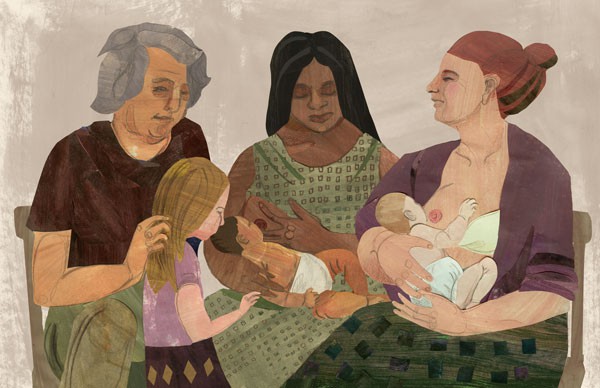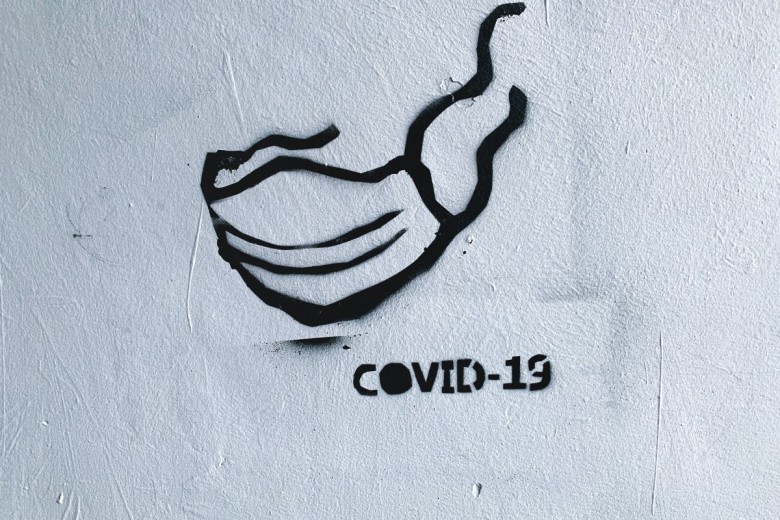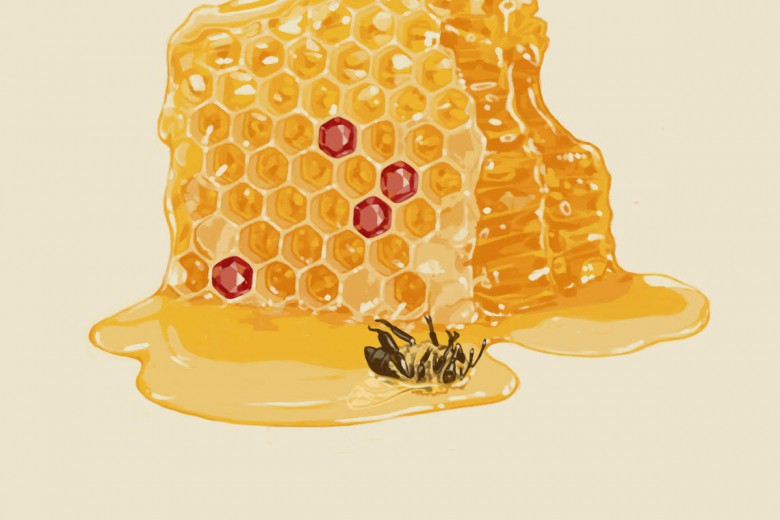
Ninety per cent of pregnant families in Canada plan to breastfeed their children. After the recommended six months later, less than 25 per cent of those families are still exclusively breastfeeding. This is a story of severed cultural ties to breastfeeding knowledge; “breast is best” lip service by many care providers, hospitals and government funding models; and huge marketing dollars from the big multinationals that produce artificial human milk (marketed as the more genteel “formula”).
Placing the responsibility for our dependence on these products on new parents is an exercise in victim blaming. Both baby and breastfeeding parent must learn to breastfeed. Before the 1920s, almost all babes were exclusively breastfed unless their mothers were gravely ill or had died, and then substitutes were usually only used until wet nurses could be found (which, at the turn of the century, were publicly funded in Canada). By 1975, more than three-quarters of babes were reliant on artificial human milk. In a mere half-century, the role of mothering became increasingly governed by scientific approaches such as scheduled, measured bottle feedings, and a strong shift away from the knowledge and technologies of midwives and elders.
Over the same period of time, the rise of industrial capitalism made mothering an individual act, and its strong influence twisted feminist movements, urging detachment from the domestic task of parenting. Economic pressures saw parents entering a workforce that valued schedules and monetary contributions to the household over attachment and community. Furthermore, the shift from understanding our own bodies to handing that understanding over to the patriarchal domain of physicians has eroded society’s confidence and power to overcome health issues with the support of lay experts such as family members and our own instincts.
The signs of our broken culture of breastfeeding are all around us. As a doula, I have supported families in reinitiating breastfeeding after three generations, an unfortunate reality for many. I have seen babes receive a soy-based human milk substitute without a parent’s consent or a request for pumped breast milk. Well-meaning public health nurses still leave free samples, “just in case,” when they do a home visit after only a few hours of breastfeeding support training. In a doctor’s office, I have seen sweet sepia images of a babe in arms, an innocuous multinational logo in the corner. I have witnessed a mainstream radio DJ comment that “… breastfeeding at the mall – it’s just not something you should do,” without repercussion. In one ear we hear that human milk is sacred and in the other that sharing it is disgusting and could spread disease.
Breastfeeding is not always an idyllic journey. Like in any relationship, complications can arise: infections, painful latches, fatigue and concerns with supply are all as old as breasts themselves. But where does one turn in a society where we have few sources of intimate support? Many of our parents and grandparents did not breastfeed, and our mobile lives may separate us by thousands of kilometres from supporters. Nursing each other’s infants within close circles as a way to support and teach one another is not acceptable to many as we have become more and more detached from each other and reliant on books and hands-off ways of learning.
The structural barriers to breastfeeding in Canada are abundant. Breastfeeding rates in Canada tend to increase with socio-economic status, leaving even fewer breastfeeding mentors to help overcome breastfeeding challenges in low-income communities that are unlikely to have the financial resources to hire a lactation consultant. Lactation consultants are intensively trained and wonderful resources who offer one-on-one and group lactation support, but they are not part of our publicly funded system. Despite the fact that a lactation consultation costs less than a good breast pump and so much less than even a month’s worth of artificial human milk, for many the cost is intellectually prohibitive if not financially so.
As one of the caring arts that is universally undervalued, breastfeeding support is not something our society is willing to invest in. Canada half-heartedly offers a minimum three-month, EI-supported maternity leave even though Health Canada recommends six months of human milk exclusively. Families with lower incomes are less likely to have employers that top up the 55 per cent of one’s income paid by EI or to extend it beyond the minimum three months that are legislated. Many low-income families cannot afford to take even the full three months of maternity leave available to them at such a low rate of coverage.
Screened milk banks – services that collect, process and dispense human milk donated by nursing mothers – are inaccessible to most. While, until the late 1970s, there were more than 20 human breast milk banks across Canada, there is now only one. Most closed for fear of HIV transmission and lack of testing resources. Although we now know that pasteurization will eliminate the virus in banked or hand-pumped milk, the banks remain closed.
The smell of profit has enticed large multinationals to slither into countries with high birth rates, disrupting existing dominant breastfeeding cultures through unethical methods of promoting their products, such as free samples for local hospitals and offers of gifts and sponsorship to influence health workers. These insidious practices have additional implications in places without safe drinking water where improperly reconstituted powders lead to increased diarrheal infant mortality. Even in the U.S., with relatively safe water supplies, infant diarrheal mortality is less than half as likely in breastfed infants. Financial restrictions provide tempting context for many families to stretch substitutes by further diluting them, increasing nutritional deficits. Strategically, these products are often not labelled in appropriate languages for the areas of distribution and are distributed in countries without strict labelling legislation, further increasing the risk of improper use.
While these companies portray themselves as helping and caring for families and babes, their drive for profit showed through in the 2008 scandal that saw toxic melamine added to artificial human milk to falsely and inexpensively elevate protein levels, sickening about 300,000 children in China. This led to additional testing in North America, which was not previously screening for this toxin. Though it was found in much lower levels than in China, melamine was still detectable. Melamine is not a naturally occurring component of any of the listed ingredients, and its presence is due either to the exposure of milk cows to restricted pesticides or to direct addition, neither of which is a reassuring picture of companies we are trusting to feed our newest generation.
Breastfeeding is an issue of food security. While our “breast is best” culture has increased awareness of the benefits of breast milk and the detrimental effects of artificial human milk on immune, intestinal, physical, intellectual and emotional development of individuals, the loss of food security that is experienced by any society that does not primarily breastfeed its infants generally goes unmentioned. That we depend so greatly on the highly subsidized, genetically suspect and ecologically precarious soybean and corn industries is incredibly short-sighted. We have been told that to feed our infants we have but two choices: breast milk and commercial, artificial human milk. Historical experiences have shown potential dangers of substitutes from undernourishment, contamination or improper handling; however, the strength of the messaging against non-commercial replacements is largely a product of the corporate power of artificial human milk companies.
The need for commercial, artificial human milk has been manufactured through the same intentional degradation of community that has manufactured doubt in our ability to produce milk from our breasts or food for our tables. It is not at all surprising that the years that saw dramatic decreases in breastfeeding are the same years that we gave up more and more of our gardens, our chickens and our recipes in exchange for supermarket solutions. We have been told that the work required to feed ourselves and our infants is drudgery and that time spent washing bottles and standing in line at the till is freedom.
Not only does the interruption of breastfeeding put children at direct risk from the artificial human milk products themselves, it also creates a dangerous dependence upon them. Be it declines in water quality or availability, disruptions in distribution, or violent combat or natural disasters that force people from their homes, families who have become dependant on large corporations, rather than each other, to feed their children can easily find themselves unable to feed their children when crisis hits.
The damage that has been done to the security of our entire food system is becoming more and more apparent every day. The movement of our society toward the industrial production of food has impacted people around the world by degrading land and cultural practices and disrupting the abilities of communities to support each other and themselves. Protecting these resources for future generations needs to have deep roots in the way that we feed our societies’ newest members. We should not be relying on the questionable practices of and ingredients from industrial agribusiness and faceless multinational corporations. We need to regain the community connections that have been supplanted by brand loyalty and proudly support each other to feed the next generation from our breasts.


_780_520_90_s_c1.jpg)


